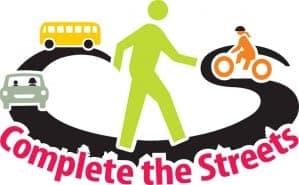
News
By Guest Contributor, March 4, 2024
By Barbara McCann
The term complete streets was coined 20 years ago on December 3rd, 2003. That’s when, working in the private sector, I wrote a memo to the bicycle community about a series of meetings I organized aimed at finding a better term for what was then called the “routine accommodation” of bicycles into street projects.
 The term suggested was “Complete the Streets for safer bicycling and walkable communities.” This was 2 years before I helped a group of public interest, health, and practitioner organizations form the National Complete Streets Coalition. What followed was an effort that collected real-world Complete Streets policies, identified their most effective elements, and helped communities across the country adopt and implement ever-better ways to ensure safety and access for all users in transportation projects. The movement quickly grew to encompass people with disabilities and people taking transit, and to address the needs of disadvantaged communities.
The term suggested was “Complete the Streets for safer bicycling and walkable communities.” This was 2 years before I helped a group of public interest, health, and practitioner organizations form the National Complete Streets Coalition. What followed was an effort that collected real-world Complete Streets policies, identified their most effective elements, and helped communities across the country adopt and implement ever-better ways to ensure safety and access for all users in transportation projects. The movement quickly grew to encompass people with disabilities and people taking transit, and to address the needs of disadvantaged communities.
Thousands of planners, engineers, and others in government, consulting, and public interest groups have worked since to make safety for all users routine in policies and in practice. Now more than 1,700 Complete Streets policies are remaking transportation projects across the country.

In my case, I entered Federal service in 2014 and in the spring of 2021 was given the opportunity to co-chair a Complete Streets Working Group that gathered expertise from across the Federal Highway Administration and the Federal Transit Administration. Our first task was to answer a request from Congress to ‘review our own policies, rules and procedures to determine their impact on safety for all users.’ In a report to Congress entitled “Moving to a Complete Streets Design Model,” FHWA identified five areas of opportunity to make Complete Streets FHWA’s default approach, ranging from better data collection and analysis to more rigorous safety assessments.
In November of 2021, the Bipartisan Infrastructure Law created a Federal definition of complete streets policies, and provided several programs to support their adoption and implementation. The law required States and MPOs to use 2.5 percent of their planning funds on Complete Streets policy development, it increased safety funding to States by more than $4 billion and required States with a high proportion of pedestrian and bicycle fatalities to use at least 15 percent of these funds on multimodal safety—in some States this is resulting in millions of dollars for safe walking and bicycling. And the new Safe Streets and Roads for All Users grant program has awarded more than $1.6 billion to regional, Tribal, and local agencies for plans and projects, with billions more to come.
Complete Streets is now one part of a much wider embrace of the Safe System Approach in the USDOT’s National Roadway Safety Strategy, as the United States faces the challenge of historically high traffic fatalities. FHWA has been making changes to its guidance and policies so that funding and designing Complete Streets becomes the easiest option for stakeholders. This includes new guidance on how to use repaving and rehabilitation projects to accelerate safety improvements and guidance on what factors to consider when working to provide safety for pedestrians and bicyclists, and much more. You can keep track of our work at the FHWA Complete Streets webpage.
I’m grateful for the contributions so many people and organizations have made to a safer multimodal future since I first penned that memo back in 2003.
 Barbara McCann now serves as Senior Advisor to the Associate Administrator for Safety at the Federal Highway Administration and is co-chair of the FHWA’s Complete Streets Working Group. Prior to entering Federal service in 2014 she was the founding Executive Director of the National Complete Streets Coalition.
Barbara McCann now serves as Senior Advisor to the Associate Administrator for Safety at the Federal Highway Administration and is co-chair of the FHWA’s Complete Streets Working Group. Prior to entering Federal service in 2014 she was the founding Executive Director of the National Complete Streets Coalition.
Related News

© 2025 Smart Growth America. All rights reserved
Site By3Lane Marketing












